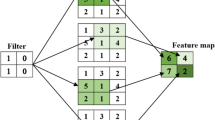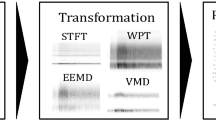Abstract
This study proposed a new method to intelligently, rapidly, and effectively identify the degrees of grinding burn and the metallographic structures based on the characteristics of binary images and neural network. This research extracted the information of five characteristic parameters, such as the fractal dimension, Euler number, mean pixel value, contrast (CON), and angular second moment (ASM) from binary image samples of different metallographic structures. Furthermore, the distribution ranges and variation of each characteristic parameter of different metallographic structures were analysed statistically. The research verifies that the metallographic structures and the degrees of grinding burn of grinding surfaces can be effectively identified based on characteristics of binary images by combining a probabilistic neural network (PNN) with self-organising competitive networks.
Similar content being viewed by others
References
Hu QY, Zhao HD, Li FD (2016) Effects of manufacturing processes on microstructure and properties of Al/A356–B4C composites. Mater Manuf Process 31:1292–1300
Pantale O, Bacaria JL, Dalverny O (2004) 2D and 3D numerical models of metal cutting with damage effects. Comput Methods Appl Mech Eng 193(4):383–4399
Fan J, Guo X, Wu C, Crupi V, Guglielmino E (2015) Influence of heat treatments on mechanical behavior of FV520B steel. Exp Tech 39:55–64
Ren SB, Xu H, Chen JH (2016) Effects of sintering process on microstructure and properties of flake graphite-diamond/copper composites. Mater Manuf Process 31:1377–1383
Chen X, Rowe WB, Mills B, Allanson DR (2000) Analysis of the transitional temperature for tensile residual stress in grinding. J Mater Process Technol 107:216–221
Wang L, Tian XL, Wang WL (2015) Cutting and extruding processing technology for ceramics based on edge-chip** effect. Int J Adv Manuf Technol 84:673–678
Wang L, Tian XL, Wang WL (2017) Evaluation of machined surface quality of Si3N4 ceramics based on neural network and grey-level co-occurrence matrix. Int J Adv Manuf Technol 89:1661–1668
Xu YJ, Zhu YY, **ao GR (2014) Application of artificial neural networks to predict corrosion behavior of Ni–SiC composite coatings deposited by ultrasonic electrodeposition. Ceram Int 40:5425–5430
Marzieh MA, Chen ZX, Wang L (2014) Feed forward artificial neural network to predict contact force at medial knee joint: application to gait modification. Neurocomputing 139:114–129
Boniha L, Kobayashi E, Castellano G (2003) Texture analysis of hippocampal sclerosis. Epilepsia 44:1546–1550
Gadelmawla ES (2004) A vision system for surface roughness characterization using the gray level co-occurrence matrix. NDT&E Int 37:577–588
Zhang J, Tong LZ, Wang L (2008) Texture analysis of multiple sclerosis: a comparative study. Magn Reson Imaging 26:1160–1166
Fernando RDS, William RS, Helio P (2013) Multi-scale gray level co-occurrence matrices for texture description. Neurocomputing 120:336–345
David AC, Zhao YP (2003) Grey level co-occurrence integrated algorithm (GLCIA): a superior computational method to rapidly determine eco-occurrence probability texture feature. Comput Geosci 29:837–850
Author information
Authors and Affiliations
Corresponding author
Rights and permissions
About this article
Cite this article
Wang, L., Tian, X., Liu, Q. et al. Grinding burn evaluation for 20CrMnTi steel based on binary images and neural network. Int J Adv Manuf Technol 93, 4033–4042 (2017). https://doi.org/10.1007/s00170-017-0866-0
Received:
Accepted:
Published:
Issue Date:
DOI: https://doi.org/10.1007/s00170-017-0866-0




